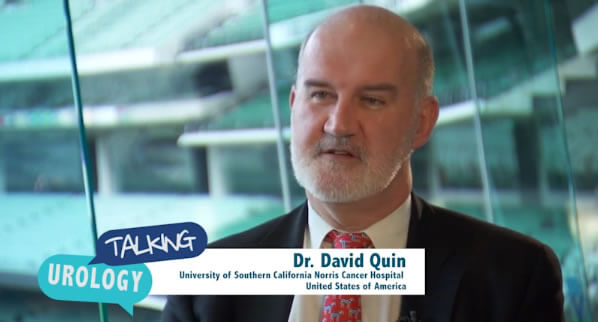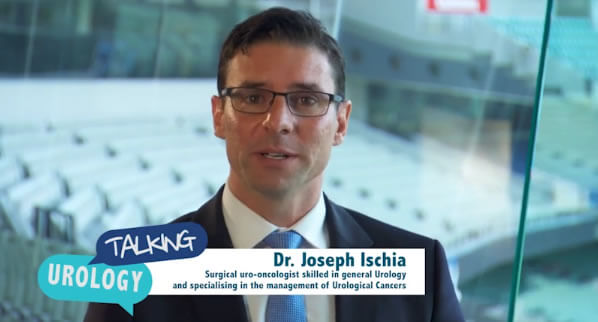USANZ 2017 – Dr Laurence Klotz (2)
Laurence Klotz, MD is Chief of Urology at Sunnybrook Health Sciences Centre and Professor of Surgery at the University of Toronto.
Laurie outlines his 20-year experience of active surveillance and how they have tightened up the criteria around Gleason 3 + 4 cancers.
Joseph & Laurie discuss surgery vs radiation which was one of the more controversial talks.
Talking Urology podcast transcript
USANZ 2017 Interviews – Laurence Klotz [2]
This is Talking Urology.
Joseph Ischia: I’m Talking Urology with Lauri Klotz who gave a couple of fantastic talks at the USANZ conference. I want to focus on your first one, Lauri. Active surveillance, you’re one of the pioneers, what was some of the highlights of your talk today?
Dr Laurence Klotz: Well, I really made four points. One is that the approach to active surveillance has changed pretty substantially since we started this close to 20 years ago. We now have a much better idea of who are the bad actors, why some patients are failing. We took an inclusive approach initially, including Gleason 6 and selected patients with higher grade cancer, and we now have the benefit of long-term follow up on these patients. And our analysis has showed that while the PSA at baseline isn’t very predictive, the presence of any Gleason 4 pattern at diagnosis conferred almost to four times greater risk of progression of metastatic disease over 15 years. So, we have stepped back a bit. We’re more cautious with the Gleason 7s. We do offer it to selected patients where there’s only a very small amount, less than 5% or 10% Gleason 4, because a lot of those are artifactually upgraded. But, in a younger man with Gleason 3+4 nowadays, we really discourage him from having surveillance unless he falls in that very borderline category, which would also mean negative MRI. The next point is that interestingly, The Hopkins Group, which took a restrictive approach and had the benefit of fewer progression to metastatic disease, has liberalized their approach. So, there has kind of been a convergence from very inclusive on our part and very restrictive on theirs. Now, I think most people, including myself, believe that almost all patients with Gleason 6 should be managed conservatively, recognizing that there’s some borderline cases who are at risk for harboring higher grade cancer particularly in younger man in whom treatment may be warranted.
Joseph Ischia: How about how about the high volume Gleason 6 in a young man?
Dr Laurence Klotz: So, again, the significance of high volume is not they need to be treated, because the evidence is very clear that Gleason 6 is a non-metastasizing cancer. The problem with higher volume is there is an increased risk for harboring higher grade cancer, so you got to scrutinize the mark carefully. They should clearly have an MRI. If it shows a target, they should have a targeted biopsy. In my view, if that doesn’t show higher grade cancer, there may also be a role for one of the genetic biomarker tests in that group. But if everything pans out, all they have is Gleason 6, nothing unusual, we manage those patients conservatively, even if they’re younger. Again, we have a deep conviction based on huge studies that you do not have to worry about metastatic disease with Gleason 6 cancer. The final point I can make is that a lot of the time these low-risk patients are middle-aged guys who haven’t had a lot of medical attention and, as the urologist, you maybe actually their main access to the medical system. So, I think there’s a role for the urologist to act as the primary care physician with these guys, you know, get them to stop smoking, lose weight, be physically active. There’s probably a role for some interventions with statins and perhaps with other micronutrients to try and reduce the risk of progression in this pace. I’m very pro statin in the surveillance cohort.
Joseph Ischia: Wonderful. Now, let’s get on to your more controversial talk, which was surgery versus radiation comparative trials. What were your highlights from that talk?
Dr Laurence Klotz: So, the title was surgery versus radiation, what is the evidence about comparative effectiveness? And so, there are in the literature 14 studies that compare the mortality outcome of surgery versus radiation using propensity analysis to adjust for relevant covariance. Because the obvious problem is that you take a group of radiation versus surgery patients. The surgery patients tend to be healthier, often tend to be younger. So, there are techniques to compensate for those variables called propensity adjustment, and beyond those 14, there’s another five studies that use some other type of adjustment, one is called instrumental analysis to adjust for the covariance. And what is striking about these studies is that essentially they are 100% consistent in showing that the prostate cancer mortality is roughly two times higher in the patient treated with radiation than surgery. Now, why should that be? Because radiation is actually quite effective therapy for prostate cancer particularly modern radiation. So, there’s several reasons why that may be. One, of course, is that the data is all nonsense, that there is a systemic underlying bias involving every single one of these studies. In my opinion, that is not the most likely explanation. There’s two others, one is that starting with surgery, just like testicular cancer, for example, where you get a surgical grading and staging, that drives subsequent management. With radiation, you don’t have that, and I think it may be the benefit of surgical staging of the entire prostate, the lymph nodes, positive margins, role of adjuvant therapy in the long run may drive improved outcome in terms of mortality. The second is some very recent data that comes from Ros Eeles’ lab in the UK that compared the outcome of patients with BRCA mutations treated with surgery and radiation, and the striking observation is that the BRCA mutated patients, this is in other words germline BRCA mutation patients, did extremely poorly with radiation. It’s as if it was completely ineffective and this has not been identified before. And that could be an explanation, because since the BRCA mutation patients represent a very high-risk cohort much higher risk of dying of cancer. Maybe they are accounting for some of the increased deaths in the radiation cohort and maybe this explains why if you look at mortalities and endpoint, again, most patients with prostate cancer are not dying of disease. If you look at mortality endpoint, you see more deaths in the radiation than the surgery. So, my message is radiation clearly has a role; it’s good treatment. But let’s move on from the rhetoric that the mortality outcomes from these are the same based on published data, it clearly is not the case.
Joseph Ischia: Are there any flies in the ointment regarding the benefits of surgery? ProtecT trial?
Dr Laurence Klotz: Yeah, so ProtecT trial, I think, there’s a risk of misinterpreting the ProtecT trial. The key thing about the ProtecT trial, and people have said to me since I started talking about this, “Oh, wait for the ProtecT trial because that’s a randomised trial.” In the propensity adjusted trials, some of them have more than 60,000 patients. The ProtecT trial had approximately 500 patients in each arm, but 75% of the patients were low-risk patients. So, the number of actual patients who had significant cancer, where you can actually learn something about surgery versus radiation, was 120 in each arm. Unfortunately, that is very significantly underpowered to show a difference plus the follow up was only 10 years. So, I think there’s been a lot of misinterpretation of the ProtecT trial in two ways. One, it was clearly underpowered to show a difference between surgery and radiation and to short follow up. The other point, which I feel strongly about, is the progression rate was higher in the conservative management arm, and there are two problems with that. One is you have, of course, a quarter of the patients are intermediate high risk, so we wouldn’t put those patients on surveillance today, and second, it wasn’t really an active surveillance protocol the way we advocate with serial biopsy intervention if there’s upgrading. It was a very kind of ad hoc approach to conservative management and, therefore, I think it’s not that surprising that they had an increased rate of progression, again, notwithstanding no difference in cause-specific survival. So, I don’t think that in any way undermines the case for surveillance. It actually supports the case for surveillance.
Joseph Ischia: Thanks very much, Laurence. It’s been an absolute pleasure.
Dr Laurence Klotz: Pleasure.










